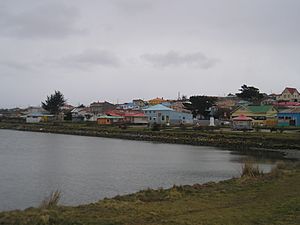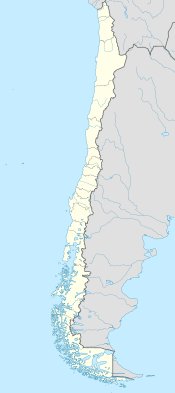Tierra del Fuego Province, Chile facts for kids
Quick facts for kids
Tierra del Fuego Province
Provincia de Tierra del Fuego
|
||
|---|---|---|

Porvenir
|
||
|
||

Location in the Magallanes Region
|
||
| Country | ||
| Region | ||
| Capital | Porvenir | |
| Communes | Porvenir Primavera Timaukel |
|
| Government | ||
| • Type | Provincial | |
| Area | ||
| • Total | 22,592.7 km2 (8,723.1 sq mi) | |
| Population
(2012 Census)
|
||
| • Total | 6,656 | |
| • Density | 0.294608/km2 (0.76303/sq mi) | |
| • Urban | 4,734 | |
| • Rural | 2,170 | |
| Sex | ||
| • Men | 4,418 | |
| • Women | 2,486 | |
| Time zone | UTC-3 (CLST) | |
| • Summer (DST) | UTC-3 (CLST) | |
| Area code(s) | 56 + 61 | |
| Website | Government of Tierra del Fuego | |
Tierra del Fuego Province (which means Land of Fire in Spanish) is one of four provinces in southern Chile. It is part of the Magallanes and Antártica Chilena region, also known as Region XII. This province covers the western part of the main island of Tierra del Fuego.
The only part of the main island not in this province is the area south of the Cordillera Darwin. That small part belongs to Antártica Chilena Province. It's good to know that Argentina also has its own Tierra del Fuego Province on the eastern side of the island.
The Chilean part of Tierra del Fuego has two main towns. These are Porvenir, which is the capital of the province, and Cerro Sombrero. There are also a few smaller villages. One interesting place is Bahía Inútil. This name means "Useless Bay" in Spanish. British mapmakers gave it this name in the late 1800s because it wasn't a good place for ships to dock.
Geography and Climate
This province is known for its beautiful natural features. You can find many small lakes here, like Lago Blanco and Lago Deseado. The climate in Tierra del Fuego Province is quite cold. It's a Subpolar Oceanic climate, which is very close to a Tundra climate. This means it has cool summers and cold winters.
Some areas along the coast of Tierra del Fuego Province have sands that contain gold. People have found gold in these sands at different spots.
Population and People
According to a census taken in 2002 by the National Statistics Institute (INE), the province covers a large area of about 22,593 square kilometers (8,723 square miles). At that time, about 6,904 people lived there. This included 4,418 men and 2,486 women.
Because the area is so big and the population is small, Tierra del Fuego Province does not have many people living in it. It is one of the least populated provinces in Chile. Most of the people, about 4,734 (68.6%), live in towns or cities. The rest, about 2,170 (31.4%), live in rural areas. Between 1992 and 2002, the number of people living in the province went down slightly.
A Look at History
The islands around Tierra del Fuego have been home to people for thousands of years. Early humans came to the Americas and settled in these areas. For example, in the Wulaia Bay area on Navarino Island (which is south of this province), there is proof that the Yaghan people lived there over 10,000 years ago.
Later, in the late 1800s and early 1900s, there was a gold rush in the area. Many people came hoping to find gold.
See also
 In Spanish: Provincia de Tierra del Fuego (Chile) para niños
In Spanish: Provincia de Tierra del Fuego (Chile) para niños



